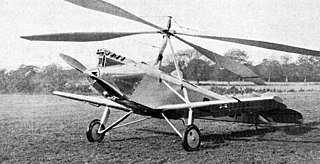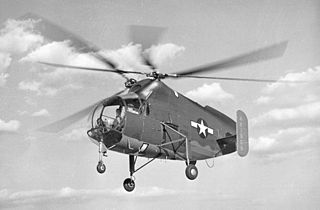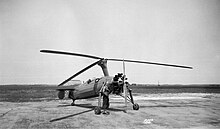
An autogyro, or gyroplane, is a class of rotorcraft that uses an unpowered rotor in free autorotation to develop lift. While similar to a helicopter rotor in appearance, the autogyro's unpowered rotor disc must have air flowing upward across it to make it rotate.

The Curtiss Falcon was a family of military biplane aircraft built by the American aircraft manufacturer Curtiss Aeroplane and Motor Company during the 1920s. Most saw service as part of the United States Army Air Corps as observation aircraft with the designations O-1 and O-11, or as the attack aircraft designated the A-3 Falcon.

The Cierva C.30 is an autogyro designed by Juan de la Cierva and built under licence from the Cierva Autogiro Company by A V Roe & Co Ltd (Avro), Lioré-et-Olivier and Focke-Wulf.

The Pitcairn OP-1 was the first rotary-wing aircraft to be seriously evaluated by any of the world's major air forces. The machine was not a helicopter, nor an airplane, but an autogyro. Pitcairn's model was never put into production for any military.

The Kayaba Ka-1 and Ka-2 were Japanese autogyros, seeing service during World War II for artillery spotting.
The Cierva Autogiro Company was a British firm established in 1926 to develop the autogyro. The company was set up to further the designs of Juan de la Cierva, a Spanish engineer and pilot, with the financial backing of James George Weir, a Scottish industrialist and aviator.

The Platt-LePage XR-1, also known by the company designation PL-3, was an early American transverse rotors helicopter, built by the Platt-LePage Aircraft Company of Eddystone, Pennsylvania. The winner of a United States Army Air Corps design competition held in early 1940, the XR-1 was the first helicopter tested by the USAAF, flying in 1941. The flight testing of the XR-1 proved troublesome, and although continued testing showed that the design had promise, other, improved helicopters were becoming available before the XR-1 was ready for service. As a result, the development of the aircraft was terminated in 1945.

The Cierva C.8 was an experimental autogyro built by Juan de la Cierva in England in 1926 in association with Avro. Like Cierva's earlier autogyros, the C.8s were based on existing fixed-wing aircraft fuselages – in this case, the Avro 552.

The Cierva C.17 was a British experimental autogyro built by Cierva Autogiro Company in England in 1928, in association with Avro. It was an attempt to build upon the successful Cierva C.8 design using the smaller, more streamlined fuselage of an Avro Avian IIIA as a starting point. The type was found to be underpowered, and when the first attempt at fitting a more powerful engine still did not result in acceptable performance, the design was abandoned.

The Cierva C.19 was a 1930s British two-seat autogyro, designed by Spanish engineer Juan de la Cierva. It was built by Avro as the Avro Type 620. It proved to be the most successful and widely produced of the early de la Cierva designs.

The Kellett Autogiro Corporation was an American aircraft manufacturer from 1929 based in Philadelphia, named after founder W. Wallace Kellett.

The Kellett K-2 was a two-seat autogyro developed in the United States in the early 1930s. Later examples were designated K-3 and K-4 when equipped with more powerful engines. K-3 NC 12691 is seen in the 1934 movie, It Happened One Night.

The Kellett XR-8 was a helicopter built in the United States during World War II. It was a two-seat machine intended to demonstrate the feasibility of a twin-rotor system and, while it accomplished this, it also demonstrated a number of problems that prevented further development of this particular design.

The Pitcairn PA-34 and Pitcairn PA-33, given the United States Navy (USN) designation Pitcairn OP-2 and United States Army designation Pitcairn YG-2 respectively were reconnaissance autogyros designed and built in 1936 for evaluation.

The Pitcairn PCA-2 was an autogyro developed in the United States in the early 1930s. It was Harold F. Pitcairn's first autogyro design to be sold in quantity. It had a conventional design for its day – an airplane-like fuselage with two open cockpits in tandem, and an engine mounted tractor-fashion in the nose. The lift by the four-blade main rotor was augmented by stubby, low-set monoplane wings that also carried the control surfaces. The wingtips featured considerable dihedral that acted as winglets for added stability.
The Cierva C.29 was a five-seat British cabin autogyro built in 1934 as a joint venture between Westland Aircraft and Cierva. The rotor system and rotors were designed by Cierva and the fuselage by Westland. It was powered by a 600 hp (447 kW) Armstrong Siddeley Panther II engine with a two-bladed tractor propeller; the engine also drove the three-bladed rotor via a clutched shaft. The C.29 suffered from ground resonance during ground running and was not flown. It was later acquired for evaluation by the Royal Aircraft Establishment but it was unable to cure the resonance problem and the autogyro was scrapped in 1939.

The Buhl A-1 Autogiro was an autogyro optimised for air camera work designed and built from 1930. To this end, Etienne Dormoy designed the Buhl A-1, an autogyro with a pusher engine located behind the pilot and camera operator. The Buhl A-1 was the first pusher style autogyro.

John MacDonald Miller was a barnstorming pilot, the first person to make a US transcontinental flight in a rotorcraft, the first to land a rotorcraft on the roof of a building, and the first to fly a scheduled US mail rotorcraft service. He was also a test pilot and airline captain. He became the oldest active pilot in the US, making his first flight on his 18th birthday and ending at the age of 101. He died aged 102.

The 1933 experimental Pitcairn PA-22 was one of the first wingless autogyros. It was controlled by movement of the rotor plane rather than the usual control surfaces, though initially the much modified lone example retained rudders as a precaution.



















